The Plextor M8Pe (512GB) SSD Review
by Billy Tallis on December 14, 2016 9:00 AM ESTATTO
ATTO's Disk Benchmark is a quick and easy freeware tool to measure drive performance across various transfer sizes.
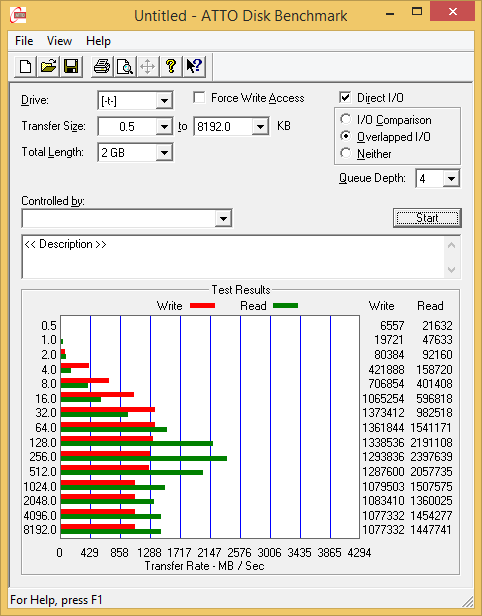 |
|||||||||
The two configurations of the M8Pe ramp up identically as transfer size increases, but the M8PeGN without the heatsink starts throttling right after it hits full performance.
AS-SSD
AS-SSD is another quick and free benchmark tool. It uses incompressible data for all of its tests, making it an easy way to keep an eye on which drives are relying on transparent data compression. The short duration of the test makes it a decent indicator of peak drive performance.
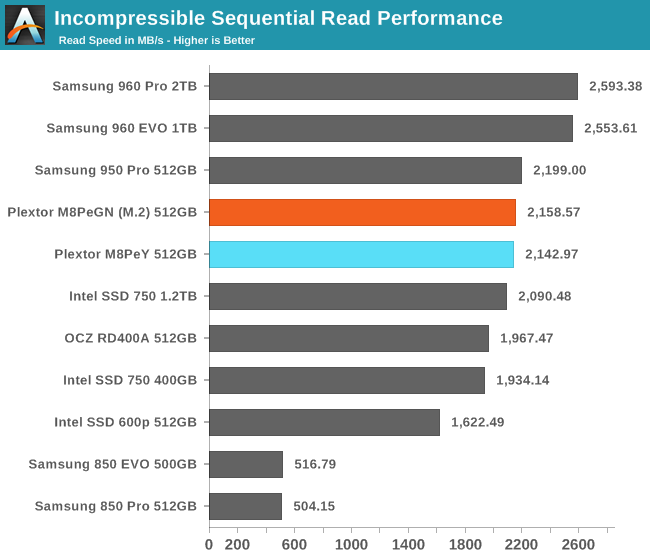
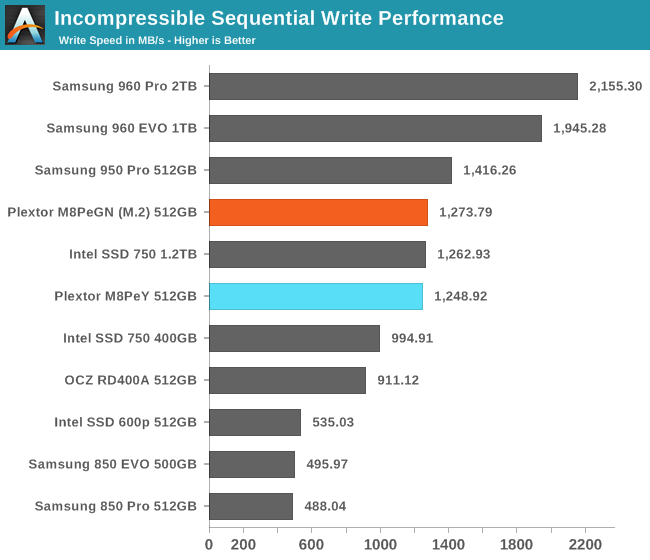
The M8Pe delivers short-duration sequential speeds that are second only to Samsung's PCIe SSDs, and tied with the much larger 1.2TB Intel SSD 750.
Idle Power Consumption
Since the ATSB tests based on real-world usage cut idle times short to 25ms, their power consumption scores paint an inaccurate picture of the relative suitability of drives for mobile use. During real-world client use, a solid state drive will spend far more time idle than actively processing commands.
There are two main ways that a NVMe SSD can save power when idle. The first is through suspending the PCIe link through the Active State Power Management (ASPM) mechanism, analogous to the SATA Link Power Management mechanism. Both define two power saving modes: an intermediate power saving mode with strict wake-up latency requirements (eg. 10µs for SATA "Partial" state) and a deeper state with looser wake-up requirements (eg. 10ms for SATA "Slumber" state). SATA Link Power Management is supported by almost all SSDs and host systems, though it is commonly off by default for desktops. PCIe ASPM support on the other hand is a minefield and it is common to encounter devices that do not implement it or implement it incorrectly. Forcing PCIe ASPM on for a system that defaults to disabling it may lead to the system locking up; this is the case for our current SSD testbed and thus we are unable to measure the effect of PCIe ASPM on SSD idle power.
The NVMe standard also defines a drive power management mechanism that is separate from PCIe link power management. The SSD can define up to 32 different power states and inform the host of the time taken to enter and exit these states. Some of these power states can be operational states where the drive continues to perform I/O with a restricted power budget, while others are non-operational idle states. The host system can either directly set these power states, or it can declare rules for which power states the drive may autonomously transition to after being idle for different lengths of time. NVMe power management including Autonomous Power State Transition (APST) fortunately does not depend on motherboard support the way PCIe ASPM does, so it should eventually reach the same widespread availability that SATA Link Power Management enjoys.
We report two idle power values for each drive: an active idle measurement taken with none of the above power management states engaged, and an idle power measurement with either SATA LPM Slumber state or the lowest-power NVMe non-operational power state, if supported.
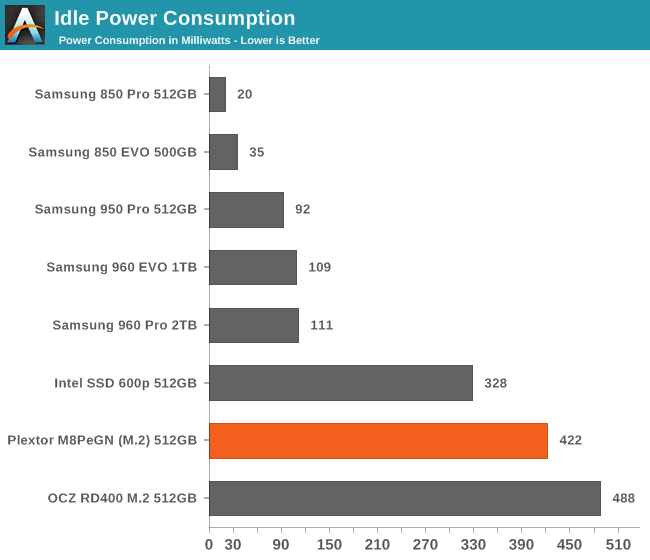
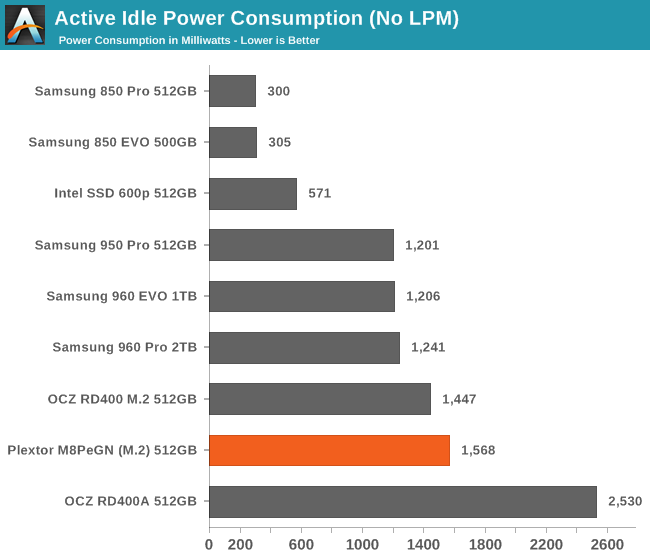
Samsung is still the only PCIe SSD vendor that has made significant progress with idle power management. Even when put into the lowest power state, The M8Pe (and the Intel 600p and OCZ RD400) consume more power than most idle SATA drives with no power saving features engaged.
When NVMe power management is not supported or not enabled, the Plextor M8Pe doesn't look too bad by comparison, as even Samsung's PCIe drives idle at 1.2 W compared to the M8Pe's 1.5 W.










64 Comments
View All Comments
Magichands8 - Wednesday, December 14, 2016 - link
This is amazing! Tiny 128GB SSDs for $0.64/GB! And look at that 1TB for $0.51/GB! We even get to use a crappy Microsoft bundled driver for these! Who knows, in 2017 we may even get to see consumer SSDs reach $0.80, $0.90 or even $1+ per GB... Time doesn't stand still and neither does the endless march of progress. Brace yourselves guys, the future's going to be an amazing place.ironwing - Thursday, December 15, 2016 - link
What is a the reason that PCIe SSDs consume more power than SATA SSDs? Is it simply the higher speeds? The review covered the sleep state issues with the PCIe drives but when the drives are in a similar state, the SATA drives appear to be much more power efficient.Billy Tallis - Thursday, December 15, 2016 - link
I think the biggest problem is that the NVMe power saving states I'm testing don't include reducing the PCIe link speed or width. Keeping a PCIe 3.0 x4 link lit up takes a significant amount of power. The SATA drives by contrast are being told to put the SATA link in a low power state and take that as the signal to engage internal power saving mechanisms.bbhaag - Thursday, December 15, 2016 - link
Thanks for the great review Billy. I've been holding off on buying the Plextor for my new build hoping that Anandtech would put up a review and you guys delivered. Looks like they are solid drives at a mediocre price point. I knew I should have bought the 512 version when the egg had it for 179...sigh...oh well I can wait.DigitalFreak - Thursday, December 15, 2016 - link
$50 price difference for a heatsink? Really?Bruce427 - Friday, December 16, 2016 - link
I think that price includes a PCIe card as well.Bruce427 - Friday, December 16, 2016 - link
At first glance at published specks, it appears that the New Corsair MP500 NVMe drive may outperform the PlextorM8Pe for about the same price.Bruce427 - Friday, December 16, 2016 - link
Sorry, spell check got me. That should have been "specs."Bruce427 - Friday, December 16, 2016 - link
"specs"Billy Tallis - Friday, December 16, 2016 - link
The Corsair MP500 uses the Phison E7 controller. Next week I should have a review up of the Patriot Hellfire that is essentially the same drive. It's slower than the M8Pe on almost every test.